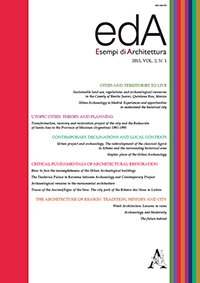Estratto da
ESEMPI DI ARCHITETTURA
International Journal of Architecture and Engineering
Transformation, recovery and restoration project of the city and the Reducción of Santa Ana in the province of Misiones (Argentina) 1992-1995
ESEMPI DI ARCHITETTURA
International Journal of Architecture and Engineering
Transformation, recovery and restoration project of the city and the Reducción of Santa Ana in the province of Misiones (Argentina) 1992-1995

The Jesuit experiment of the Misiones de Guaraníes was one of the most important works of the colonial Americas. The street system organization, the architectural characteristics of its Reducciones, the socio-economic structure, and the results obtained with the Guaraní population, made the Provincia Jesuitical of Paraguay, founded in 1607, the most densely populated and well organized of all the populations in the Rioplatense area during its maximum development in the XVIII century. The Reducciones or Misiones of the Guaraníes Indio were unique examples both for their urban and architectural models and for their social organization, recalling Plato’s Republic and the “political novels” of the XVI and XVII centuries. Some of these settlements—San Ignacio, Santa Ana, Loreto— have been declared UNESCO World Heritage Sites. The development of this singular endeavor extended, beyond geographical and administrative limits, between Bolivia, Paraguay, Brazil, and Argentina. This constructed utopia ended with the expulsion of the Jesuits in 1768. The ruins of the Misione, give testimony of a truly important historical event. They force themselves on our attention as tangible remains able to remind us of the roots today’s identity. Given the significant unity of the historical, cultural, and anthropological process of which they are testimony, it was necessary to verify the possibility of redefining the geographical, physical and spatial relations, ultimately territorial, with the intent of proposing a homogeneous ensemble. The Guaraní population in Santa Ana fluctuated between 3,800 and 4,000 people. It reached its maximum height of 4,344 inhabitants in 1768 at the time of the expulsion of the Jesuits, when together with other settlements of the ancient department of Candelaria, it passed under the rule of Paraguay until 1865. Since then, only the majestic ruins have remained to bear witness to the Jesuit experience in that region. The modern city of Santa Ana was founded in 1883 in the framework of the colonization of the Misiones. In the presence of XVIII century architecture, transformed into an archeological object where achieving a philological reconstruction didn’t seem right, especially for the false imprint the rebuilt work would have acquired. The final proposed planning works on the redefinition of the relations between the monument, the Reducción, the XIX century city and the surrounding territory. We propose rebuilding the relationship between the jesuit-guaraníes “signs” and the traces of the XIX century. The layouts, the unfinished of an architecture that can only be rebuilt in part, the tight connection with the geography of the places, have represented fundamental themes for the recovery of these settlements. The work group was comprised of: Agostino Bossi, Ludovico Maria Fusco, Luigi Pisciotti, Dante Rabitti, architects and professors of the Università degli Studi di Napoli Federico II in Naples, with the reprasentatives of the Province of Misiones, Graciela Cambas and Alfredo Poenitz, historians, Ruth Adela Poujade, archeologist, Mary E. Gonzáles, architect.
| pagine: | 37-48 |
| DOI: | 10.4399/97888548858684 |
| data pubblicazione: | Luglio 2015 |
| editore: | Aracne |








